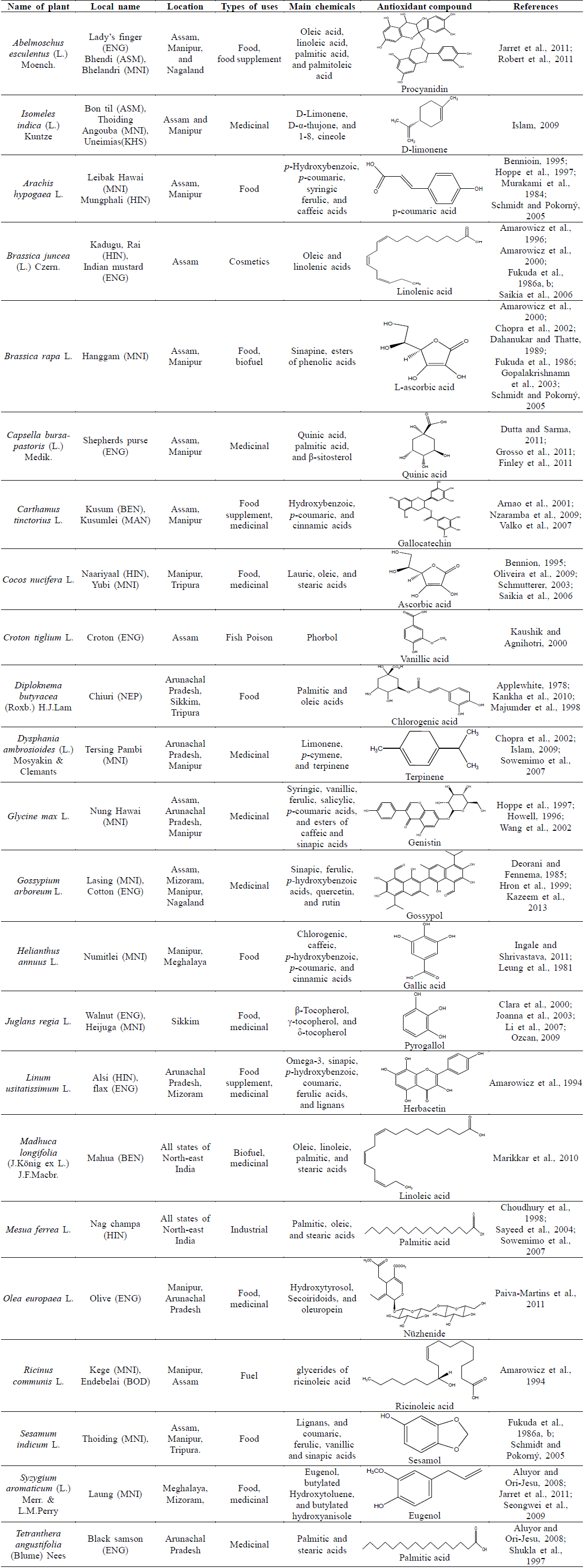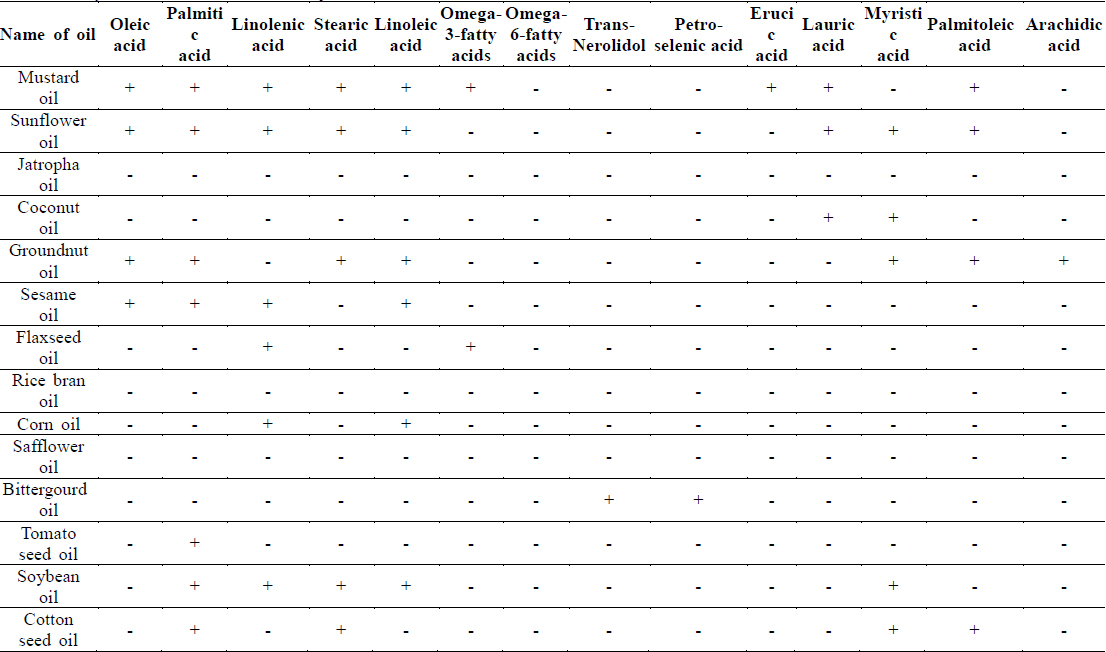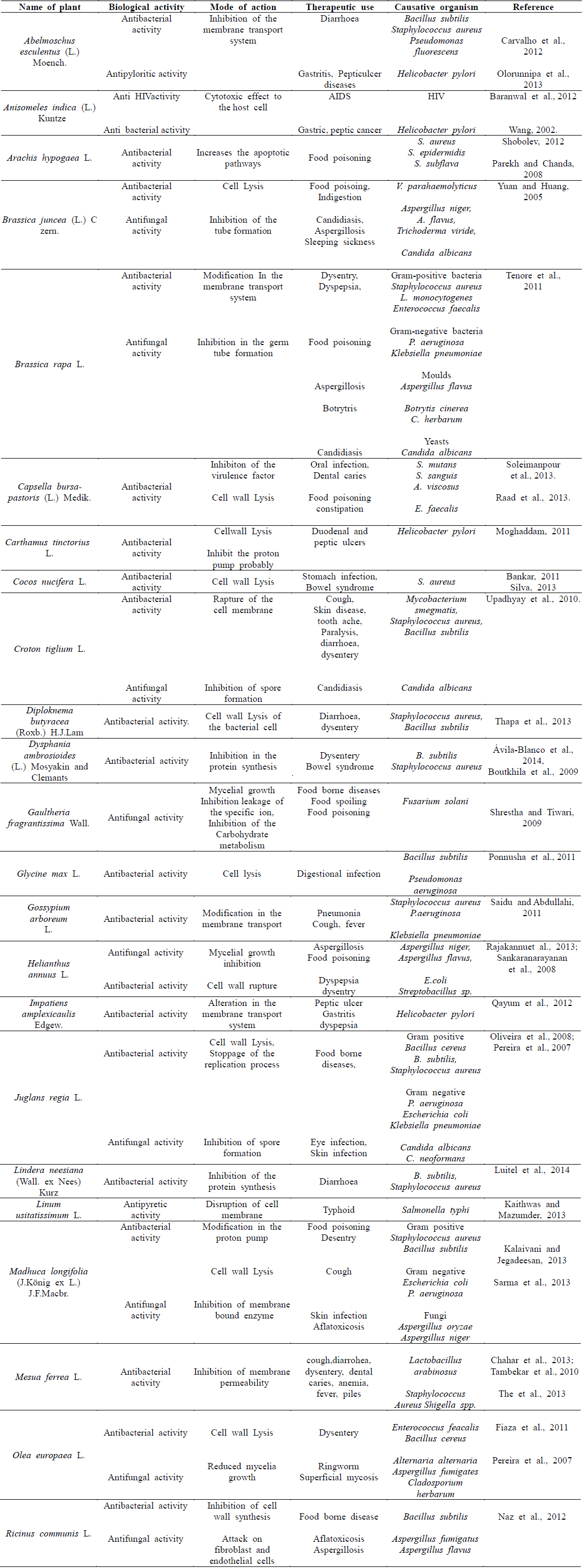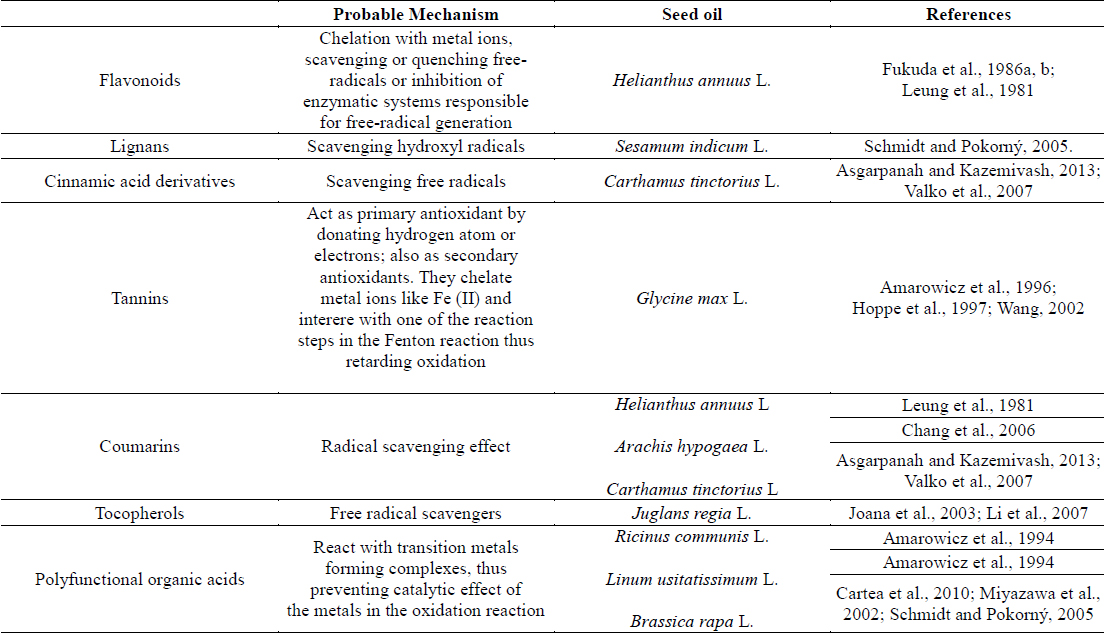



The beneficial uses of seed oil plants have been known since time immemorial. Apart from their uses as food items, oils extracted from seeds are also used for different purposes ranging from medicinal to biofuels. Their chemical compositions, physical and chemical properties generally determine their applications for different purposes.
Many microbial diseases worldwide have become a serious threat to human health because of the emergence of drug-resistant or multi-drug resistant (MDR) microbial strains (Tabassum et al., 2013). Emergence of resistance to the existing drugs (Rio s and Recio, 2005) led the scientists to search for the new alternatives including seed oil producing plants and their oil (Aktar et al., 2014), which are known for their antimicrobial properties. Several
Determination of antioxidant properties of seed oils is also significant in view of maintaining food quality and preventing many physiological problems such as oxidative stress related complications, liver cirrhosis, and cancer. Food deterioration may occur due to the presence of oxidation-prone ingredients in food items (Shukla et al., 1997). One of the current approaches to prevent this oxidative degradation is addition of natural antioxidants in food items. It is also believed that natural antioxidants can stabilize or deactivate the free-radicals. In living cells, free-radicals may incorporate highly reactive oxygen and attack healthy cells through a range of biochemical reactions (Aluyor and Ori-Jesu, 2008). These free-radical initiated reactions may subsequently lead to cancer initiation and accelerated ageing process. Plant seed oils are reported to possess antioxidant properties that can prevent oxidative stress. The antioxidant property of seed oil is generally attributed to the presence of triglycerides and various natural antioxidant components in them. Formerly, very little or no attention was given to seed oil producing plants as a source of antioxidants (Schmidt et al., 2005). However, in recent years, renewed focus on seed oils as sources of novel antimicrobial and antioxidant compounds has been observed (Jarret et al., 2011).
The region of North-East India is endowed with two biodiversity hotspots of Indo-Burma and Eastern Himalayas. This region consists of eight states of India-Arunachal Pradesh, Assam, Manipur, Meghalaya, Mizoram, Nagaland, Sikkim, and Tripura. Many oil-rich seed bearing plants grow in this region in wild or in cultivated conditions. People residing in this region are using these plants for wide-ranging purposes including consumption as food items and also for medicinal applications. Enumeration of traditionally used seed oils in this region may help in highlighting the associated biochemical properties. Moreover, exploring those plants, which are not traditionally used by the people, could open up a new vista for production of seed oils having antioxidant properties. To the best of our knowledge, there is no up-to-date review published on the seed-oil plants of North-East India focusing particularly on their antimicrobial and antioxidant potential as well as their chemical compositions. Therefore, this mini review aims to review and document traditionally used and unused seed oil plants of North-East India and also to look into their chemical compositions with special emphasis on antimicrobial and antioxidant properties.
A shortlist of the seed oil yielding plants from the region of North-East India has been prepared from published literature, both from printed and electronic resources. Scientific names reported in the form of synonyms were standardized by cross checking with the Plant List (www.theplantlist.org). A comprehensive survey of literature was performed using the electronic databases, viz., PubMed (http://pubmed.ncbi.nlm.nih.gov), Science Direct (www.sciencedirect.com) and Google Scholar (http://scholar.google.com) as well as various printed sources. Only experimentally verified chemicals were considered and their antioxidant properties were compared with records from PubChem (http://pubchem.ncbi.nlm.nih.gov) and CHEMBL (https://www.ebi.ac.uk/chembl) databases.
Seed oil yielding plants reported from North-East India have been categorized into (i) seed oils traditionally used by the ethnic communities for their oils, and (ii) seed oils not traditionally used by the ethnic communities, but used for other plant parts.
>
Seed oil plants traditionally used in North-East India
A total of 26 seed-bearing plants from North-East India have been reported for their traditional and commercial uses in this region (Table 1). Vegetable oils, predominantly seed oils, are generally procured from seeds, nuts or fruits by means of traditional processing techniques, such as the net variety system, the steam distillation, hydrodistillation technique and so on.

List of plants with oil yielding seeds traditionally used in North-east India with their antioxidant compound
>
Seed oils not traditionally used in North-East India
There are further 38 seed oil yielding plants that grow in North-East India, but their oils are not traditionally used by the indigenous people (Table 2). In certain cases, other plant parts are used by the people of the region. Scientific extraction and utilization of oil from these could enrich the seed oil resources of the region.
[Table 2.] List of NorthEast Plants with oil yielding seeds which are not traditionally used

List of NorthEast Plants with oil yielding seeds which are not traditionally used
Among these plants,
>
Usage categories of seed oils in North-East India
Seed oil producing plants reported from North-East India are used for wide-ranging purposes including uses as edible oils, various industrial items and as an alternative source of energy. Traditional uses of seed oil plants can be categorized into biofuel, cosmetics, fish poison, medicinal, food, food supplement and industrial uses. Most of the uses of the seed oil are for medicinal purposes, followed by use as food. Main consumption pattern of these seed oil plants have been highlighted in the following sections.
Consumption as edible oils is one of the most important and popular uses of plant-seed oil. The commonly used plant seeds oils from North-East India include mustard, sunflower, safflower, and coconut oil. Mustard oil is cultivated from different species of the mustard family (Brassicaceae), such as
Sunflower oil is a mixture of monounsaturated and polyunsaturated fatty acids extracted from sunflower. Although not used by the people of North-East India in the past, the plant is now cultivated in many parts of this region for seed oil.
Another important seed oil bearing plant is Safflower, which produces two types of oil - one containing high monounsaturated fatty acids (oleic acid) and the other having high polyunsaturated fatty acids (linoleic acid). Oil containing monounsaturated fatty acids is mainly used for edible purposes, while the linoleic acid rich oil is used for painting and industrial purposes. Coconut oil is also used for edible purposes in this region.
Rice bran oil is the bi-product of milling and it is emerging as important edible oil in this region. Although it was not used in the past, nowadays its popularity has increased considerably because of its health benefits.
The food supplements are generally the substances that give full source of carbohydrate and protein, and provide resistance against microbial attack and improve the immune system. Only three species of seed oil yielding plants in North-East India (
However, there are many other plants available in North-East India, which can be used as food supplements. For example, evening primrose seeds, which are generally used for the extraction of oil, are crucial for dietetic purposes (Tabassum and Singha, 2013). Extracted meal is rich in phenolics. Soybean or peanut grits, flours, pastes are regularly used in many other parts of the world as food stabilizers. In certain cases, walnuts, poppy seeds, which are rich in edible oil, are occasionally consumed as food ingredients, flavourings, salad-dressing and addictive.
In North-East India, 15 different plant seed oils are used as medicinal materials. Rapeseed oil obtained from
Methi seed oil, obtained from
There are some instances of using plant seed oils as biofuel by the traditional people in the North-East India (Yuan-Chuen and Huang, 2008). Oils extracted from mustard seeds, coconut and castor are used for religious and ritual purposes (Tenore et al, 2011). Whilt large scale extraction of seed oils for their uses as biofuel is still in its infancy, seed oil plants are slowly emerging as an important sources of biofuel and starting to pave the way towards new sources of non-renewable energy. To meet the ever-increasing demands for energy, attempts have been made to produce biodiesel from variety of plants, mainly non-edible plants found in North-East India.
A variety of plant seed oils have been providing the essential ingredients for various cosmetics since time immemorial. In spite of the presence of many plants in North-East India, traditional use of seed oil for cosmetics is rather rare. However, oil from
There are no reported traditional industrial applications of seed oils in the region. Despite that, seed oil growing in this region, can be utilized for industrial purposes, from painting to lubricant industries.
>
Chemical properties and characteristics of seed oils
Chemical characteristics of seed oils generally depend on the fatty acid composition. Presence of other compounds provide unique characteristics of seed oil. Mustard oil is characterized by the pungent odor owing to the presence of allyl isothiocyanate, which serves as defence against herbivores. This compound is stored inside the compartment of the plant cells in the form of glucosinolate (Ratzka et al., 2002). Mustard oil contains generally high amount of monounsaturated fatty acids, such as erucic acid and oleic acid, and lower amounts of polyun satu rated fatty acids comprising omega-3 α-linolenic acid and omega-6 linoleic acid. This oil also contains a little amount of saturated fats, sinapines and esters of phenolic acids (Schimdt and Pokorny, 2005).
Main components of sunflower oil are linoleic, oleic, palmitic, and stearic acids (Gunstone, 2011). Sunflower oil can be categorized by the amount of oleic acid present, high oleic acid sunflower oil (containing more than 70% of the total fatty acids) and mild oleic acid sunflower oil (containing less than 70% of the total fatty acids. Other important components are chlorogenic, caffeic, p-hydroxybenzoic, p-coumaric and cinnamic acids (Amarowicz et al., 2000). In other parts of the world, sunflower oil is used in manufacturing solid sunflower butter. Nowadays people prefer refined product of this oil for edible purposes. Though linolenic acid and linoleic acids are important for human nutrition, they may cause oxidative instability in the oil (Wang, 2002).
Coconut oil exists as solid in room temperature because of its relatively high proportion of saturated fatty acids (92%) particularly lauric acid (Adelakun et al., 2009). Important fatty acid generally includes capric acid, caprylic acid, lauric acid, linoleic acid, myristic acid, oleic acid, palmitic acid, and stearic acid (Chowdhury et al., 2007). Palm, olive, cottonseed, peanut, and sunflower oils are classed as oleic-linoleic acid oils contain high proportion of unsaturated fatty acids, such as the monounsaturated oleic acid and the polyunsaturated linoleic acid (Dunn, 2005). Other oils are categorized as the erucic acid oils, which are similar to oleic linoleic acid oils except their unsaturated fatty acid. Rapeseed and mustard seed oils are important oils of this class.
A brief summary of various compositions of fatty acids in the seed oils is given in Table 4. Castor oil (a hydroxy-acid oil), another important oil of this class contains glycerides of ricinoleic acid. Melting point of the specific chemical ingredient plays an important role in maintaining the particular bioactivity expression among the seed oil plants. Mustard oil, proved to be more effective than corn oil, because of the presence of omega-3-polyunsaturated fatty acid in it and also experimentally found effective in preventing color tumor in animals (Dwivedi and Ram, 2003).
[Table 4.] Fatty acid constituents of some major seed oil found in North-east India

Fatty acid constituents of some major seed oil found in North-east India
Rice bran oil has high content of free fatty acids, wax, and unsaponifiable matter (Shin and Kang, 2001). Its beneficial effects in the health improvement are due to the presence of compounds such as oryzanol, tocotrienols and squalene (Kochhar, 2002). Rice bran oil has high stability in their structure, probably due to the combined effect of oryzanol, phytosterols, squalene, tocopherols, and tocotrineols (Kochhar, 2002).
>
Antimicrobial properties of the seed oil plants of North-East India
A fair amount of data on the antimicrobial activity of many seed oil producing plants of North-East India is available (Avancini et al., 2000). The phenolic component of the seed oil plants are generally known for their antimicrobial activity. The possible mechanisms of action of natural compounds present in these seed oil plant involves disintegration of cytoplasmic membrane of the bacterial cell, destabilization of the proton motive force (PMF), electron flow, active transport, and coagulation of the cell content (Burt, 2004). The structure of these seed oil compounds disintegrates the external membrane of Gram-negative bacteria, releasing lipopolysaccharides (LPS), and increasing the permeability of the cytoplasmic membrane to ATP. Analysis in the antimicrobial activity of black pepper, clove, garlic, ginger, and green chilli on the human pathogenic bacteria viz.
The terpene content of the oil plays crucial role in the antifungal activity. These seed oil plants exhibit cytotoxic and phototoxic activity leading to fungicidal or fungistatic property (Rios and Recio, 2005). Similarly, inhibitory effect of clove extracts have been studied by Sakagami and Kajimura (2000) on the production of verotoxin by
Mycotoxins mediated diseases, chronic, subchronic, and acute can be treated by seed oils, but their effectiveness depends on the frequency and route of administration and dose of the oils. The other factors include the age, sex the time, and the climatic condition of the plants producing the fixed oils (Table 4).
Studies on
Light induced activation of photosensitive components of seed oil produces conjugated cytotoxic adducts of DNA (Averback et al., 1990).The process resulted cell lysis and leakage of many integral proteins of target cell (Bakkali et al., 2004). Microbial population like
>
Antioxidant properties of oil yielding plants from North-east India
Antioxidants protect the biological systems against the potentially harmful effects of several biochemical reactions causing excessive oxidation (Arnao et al., 2001), thereby preventing oxidative stress. Oxidative stress is often results in cancer, artheros clerosis, cardiovascular disorder and many other (Valko et al., 2007). Antioxidant activity is attributed by the changes in the metabolizing key enzymes and thereby controlling the unnecessary quick ageing process in the living systems (Finley et al., 2011; Nzaramba et al., 2009). Living cells possess antioxidant defense system mainly comprising of glutathione, ascorbic acid, vitamin E, superoxide dismutase, and glutathione peroxidase to protect themselves against harmful oxidative stress (Kaplowitz and Tsukamoto, 1996).
Oxidative reactions lead to formation of free-radicals. The most common compounds which are attacked by oxidation are unsaturated fats, which generally turn rancid as a consequence. These reactions are often enhanced with ferrus or copper ions. Degradation due to oxidative reactions can cause adverse effects on all biomolecules. The oils like okra seed oil, ground nut oil, linseed oil, olive oil, and sesamum oil (Tables 1 and 2), which are native to North-East India, possess antioxidant activity. These oils are capable of preventing oxidative stress by detoxifying various harmful chemical agents entering the human body. Antioxidants present in the seed oils include mainly tocopherols, flavonoids, carotenoids, and bioactive plant phenols (Table 5) (Dimitrios, 2006; Shukla et al., 1997). Oil producing seeds contain various types of phenolic compounds, such as flavonoids, lignans, lignins, phenolic acids, and tannins. Flavonoids can exert their antioxidant activity via a series of mechanisms, e.g., by chelating metal ions, by scavenging or quenching free-radicals or by inhibiting enzymetic systems responsible for free-radical generation (Dias et al., 2005; Islam, 2009). Flavonoids are the most widely present polyphenolic compounds in many oil seeds (Saikia et al., 2006).
[Table 5.] Antimicrobial Activity of the Seed Oil Plants of Northeast India

Antimicrobial Activity of the Seed Oil Plants of Northeast India
[Table 6.] Antioxidant components in seed-oil bearing plants of North-east India

Antioxidant components in seed-oil bearing plants of North-east India
Lignans are dimeric phenyl propanoids and often possess one or more phenol (Ar-OH) functionality. These compounds are considered to be protective against colon, breast, and prostate cancers (Kocchar, 2002). Tocopherols are another important antioxidant present in seed oils. α-Tocopherol exhibits vitamin E activity and prevents oxidation of lipids. The antioxidant activity of tocopherol is based on the tocopheroltocopheryl quinone redox system (Shukla et al., 1997). Tocopherol acts as free radical scavenger and thus can be used in the presservation of animal products. Sunflower oil contains high γ-tocopherol making this plant resistant to autoxidation (Arnao et al., 2001). The flax plant
Sterols are steroidal alcohols present in the oil which serve as an important antioxidant. Rapeseed oil contains sterol in free form as well as in esterified form (Raad et al., 2013; Kareru et al., 2010). A group of derivatives of hydroxytyrosol is present in olive and castor oils (Horn et al., 1999). Carotenoids have also been reported to possess high antioxidant activity, especially in the exposure to the light. Phenols present in the seed oils contribute to the antioxidant properties. Common phenolic antioxidants include butylated hydroxyanisole (BHA), butylated hydroxytoluene (BHT), propyl gallate (PG) and tertiary butyl hydroquinone (TBHQ) (Dutta and Sharma, 2011; Leung et al., 1999). Lipophilic antioxidants are more active in emulsions, while polar antioxidants are more active in bulk fats and oils.
Characteristics of edible oils can be compared through the smoke point because it reflects the molecular structure of the oil (Hunt, 1953). The smoke point of a fat or oil is the point of the temperature at which the lipid begins to disintegrate into fatty acids and glycerol to produce bluish smoke (Table 3). It marks the point from where flavour and nutrition degradation begins, and thus is an important consideration for characterizing the quality of edible oils. Oils having high smoke point are used for deep frying. Antioxidants can have influence on the features of smoke points of oils. It has been observed that the smoke point of soybean oil and lard was increased BHA, BHT or TBHQ and removing cholesterol (Yen et al., 1997). Various biofunction and probable mechanism of action of other notable seed oil plants are summarized in table 7 given below.
[Table 3.] Smoke points of some plant seed oils used in North-east India

Smoke points of some plant seed oils used in North-east India
[Table 7.] Application of various seed-oil Plants of North east India

Application of various seed-oil Plants of North east India
Seed oil yielding plants may provide an avenue for developing a new set of drugs for controlling wide range of ailments associated with oxidative stress, as well as several types of contagionus and pathogenic diseases. The northeastern states of India, being one of the largest repositories of the plant kingdom, offers various seed oil yielding plants, which could be explored further for their antioxidant activity and antimicrobial properties. Seed oils can be used to increase the self-life of the industrial food products. Thus antioxidant property present in the seed oils can be explored for wide range of applications ranging from preservation of food products to prevention of the oxidative stress related diseases, e.g. cancers and cardiovascular disorders. The antimicrobial property of the seed oil producing plants and various bioactive compounds isolated from them may lead to the discovery of new antimicrobial compounds to fight against MDR microbial strains and various forms of infections in general.








